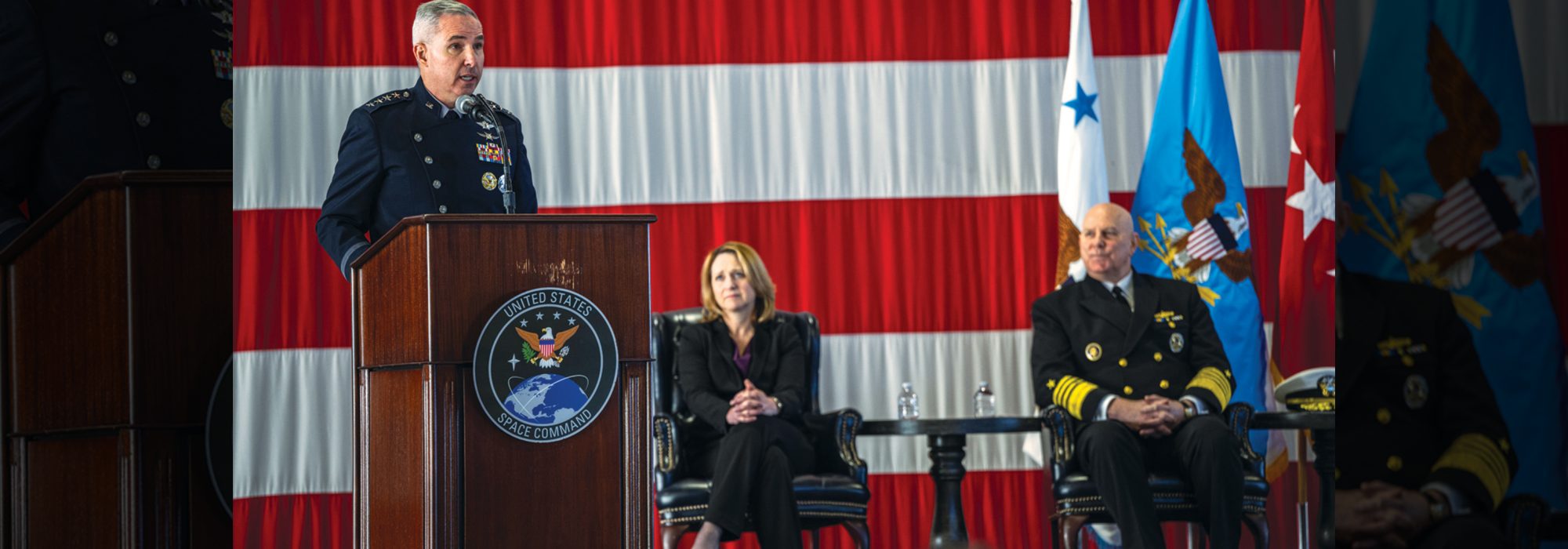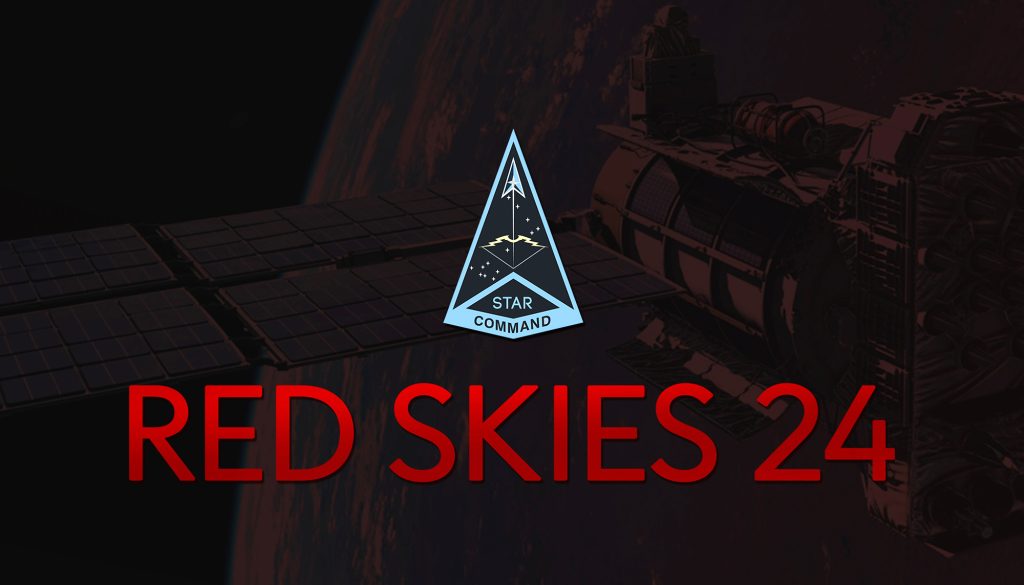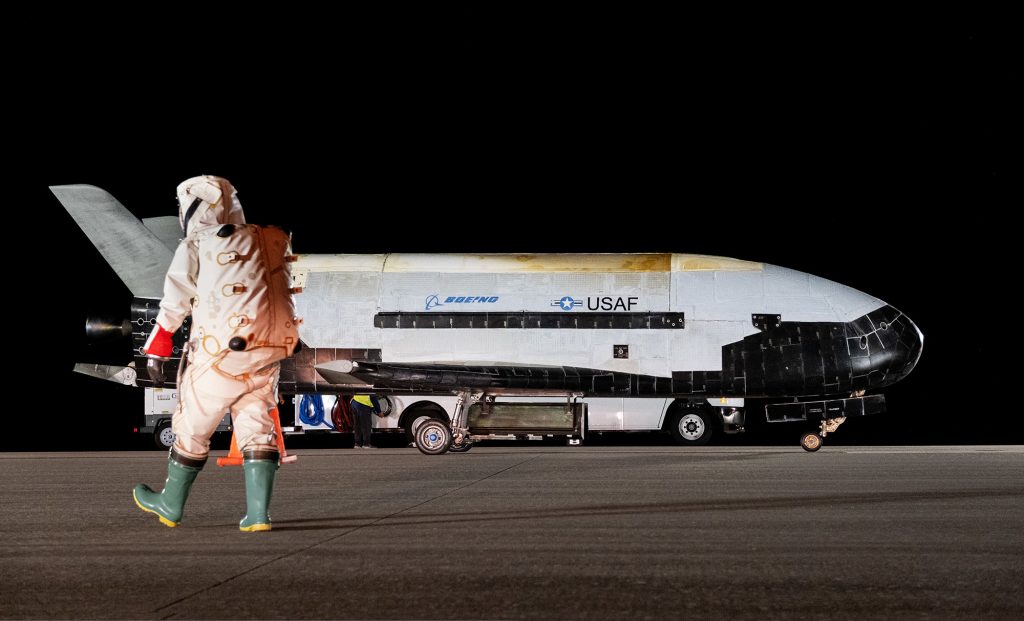Space Command Reaches FOC—With a Guardian in Charge
By Christopher Gordon and Unshin Lee Harpley
W
eeks after declaring full operational capability (FOC), Army Gen. James Dickinson handed over the controls of U.S. Space Command to Space Force Gen. Stephen N. Whiting, opening a new chapter in the command’s rapidly developing history.
“Our highest priority is to preserve freedom of action in space,” Whiting said, drumming home the importance of the command’s mission. “The People’s Republic of China and Russia consider space a warfighting domain, and their increasingly assertive actions have made space more contested. Their actions have created real threats to our national space power and the critical space infrastructure upon which our nation relies.”
SPACECOM achieved FOC following an intense evaluation that affirmed the command’s ability to function even on what Dickinson called “our worst day, when we are needed the most,” and adversaries are working to thwart U.S. advantages in space.
Full operational capability is a significant advance, which includes:
- Accomplishing the Unified Command Plan mission alongside global campaigning, exercising, and responding to crises.
- Employing the personnel with all necessary skills across the full span of military, civilian, and contractor personnel.
- Possessing the infrastructure necessary to support command and control across all mission and business functions.
- Having all necessary command processes and functions in place.
- Being able to set the conditions and requirements for the future fight.
SPACECOM is still operating under a cloud, however, as its permanent home remains a controversial point of debate. President Trump sought late in his presidency to move SPACECOM to Huntsville, Ala., but President Biden revoked that decision. Rep. Mike Rogers (R-Ala.), chairman of the House Armed Services Committee, has vowed not to give up his quest to relocate SPACECOM from Peterson Space Force Base, Colo., to Redstone Arsenal, Ala., which is just north of Rogers’ home turf—Alabama’s 3rd Congressional District.
Now that SPACECOM has reached FOC, however, Colorado lawmakers can argue against moving from its provisional headquarters because doing so would set the command back in terms of readiness. Compromise language in the 2024 National Defense Authorization Act states that a new command headquarters cannot be built until government watchdogs investigate President Joe Biden’s decision to keep SPACECOM in Colorado, which reversed a decision made by former President Donald Trump in his final weeks in office.
“Maintaining the headquarters at its current location ensures no risk of disruption to Space Command’s mission and personnel, and avoids a transition that could impact readiness at a critical time given the challenges we continue to face,” National Security Council spokesperson Adrienne Watson told Air & Space Forces Magazine in July.
U.S. Space Command was established in the fall of 2019 as a geographic combatant command—actually, “astrographic,” is SPACECOM’s new terminology. Its operational domain is everything greater than 100 kilometers above sea level. Its establishment predates the U.S. Space Force by just a few months.
In taking command of SPACECOM, Whiting spoke of the growing threats facing U.S. military forces, which depend on SPACECOM for vital intelligence, communications, navigation, and timing.
“Our highest priority is to preserve freedom of action in space,” Whiting said. “The People’s Republic of China and Russia consider space a warfighting domain, and their increasingly assertive actions have made space more contested. Their actions have created real threats to our national space power and the critical space infrastructure upon which our nation relies.”
The declaration of full operational capability “does not mean the command will stop developing capability or capacity,” SPACECOM said in its announcement. “The command, like all others, will require additional resources to keep pace with competitors and evolving threats.”
Whiting helped stand up the Space Force’s Space Operations Command. As SpOC’s first-ever commander, beginning in October 2020, he oversaw the command’s first contributions to the joint fight, including vital intelligence during Russia’s invasion of Ukraine and assistance to Israel before and after the Oct. 7 attacks on Israeli civilians by Hamas.
Whiting emphasized the close collaboration between SPACECOM and the Space Force and the challenges that can arise between military branches responsible for recruiting, training, and equipping the force and combatant commands, which have to execute war plans. “No doubt there are tensions between services and combatant commands,” Whiting said. “But let me be clear, maximizing the outcomes for the nation in space ahead of any organizational equities will be my priority.”
Deputy Defense Secretary Kathleen Hicks attended the ceremony in place of Defense Secretary Lloyd J. Austin III, who has been battling prostate cancer and was hospitalized in late 2023 and early 2024. She highlighted resilient space architectures—a new area of emphasis in space—as crucial to the U.S. response, asserting that “conflict is not inevitable.”
“The United States of America is committed to preventing conflict through deterrence by making clear to our competitors that the costs of aggression would far outweigh any conceivable benefits,” Hicks said. “Everyone at this command is part of how we do that.”
Red Skies: Space Force Launches New Exercise
By Greg Hadley
The Space Force held its first-ever “Red Skies” exercise in December, some 48 years after the Air Force held its first-ever “Red Flag,” and like the Air Force exercise, enabling Guardians to prepare for war in their domain.
Red Skies ran Dec. 11-15, challenging Guardians with simulated space threats in an exercise two years in the making. Some 45 Guardians from Deltas 2, 3, 7, 9, and 11 participated, said lead planner Capt. DeShawna Moore.
Lt. Col. Scott Nakatani, commander of the 392nd Combat Training Squadron, which led the exercise, told Air & Space Forces Magazine that the Space Force is no different than any other service trying to compete in its area of responsibility. “How do these systems respond? And what are the limits of their performance?” he said, explaining that the next step is more difficult: “Trying to survive when someone’s trying to destroy you.”
Leveraging concepts proven over half a century at Red Flag, where fighter pilots must survive under extreme pressure, Red Skies seeks to challenge space operators with realistic combat scenarios. “So just like a fighter pilot on the range out at Nellis flying at Red Flag, we are working on building up those same skill sets—the survivability skill sets, pursuing the mission through contested and dangerous environments, against observed and validated adversary tactics,” Nakatani said.
Conceived two years ago under then-STARCOM commander Brig. Gen. Shawn N. Bratton, the exercise joins others in the Space Force’s new training agenda, including “Black Skies,” focusing on electronic warfare, “Red Skies,” to highlight orbital combat, and “Blue Skies,” to focus on cyber warfare.
Brig. Gen. Todd Moore, STARCOM’s deputy commander, said the plans add to Guardians’ experience. “We have been increasing the number of exercises and trying to increase the number of venues where we’re able to give the Guardians access to scenarios to really train against an aggressor force.”
While details on the scenarios and threats Guardians faced in Red Skies remain classified, Nakatani said the exercise sought to develop tactics and procedures to protect U.S. satellites while taking into the account the cost of burning satellites’ limited fuel supplies.
“Just like an aircrew is trying to communicate to this controller back on the ground, how did the space crew flying the satellite deal with their command and control and obey so they can use their fuel budget judiciously and still achieve their objectives?” he said.
The results were encouraging, Capt. Moore reported.
“I would say my favorite portion of the scenario in general was seeing the integration between the different [teams] and how we tackle those types of challenges innovatively in order to have mission success,” Capt. Moore said.
This exercise was a simulation, but officials said they hope future Red Skies will incorporate live on-orbit assets.
“I’d love to see some real maneuvers performed, perhaps with a test asset, perhaps with a residual capability,” Nakatani said. “When I think about what’s real, and what’s exercise, there’s always a nuanced piece too. Going through your entire communications structure, I do think there are [things] on real systems that just can’t be replicated in terms of readiness.”
Plans call for the next Red Skies in fiscal 2025, Nakatani said, after which Brig. Gen. Moore said he hopes to increase the exercise’s frequency and complexity.
“I genuinely believe we need to be able to replicate Red Skies no less than quarterly,” Moore said. “ The [other] place I’d take it is increased complexity. And what I mean by increased complexity is making it a truly multidomain in timing and tactics and command and control. Really having that increase in the complexity of what we’re doing across domains, I think is really important.”
Space Planes Now ‘Most Watched Objects on Orbit’
By Greg Hadley
When the Space Force’s X-37B Orbital Test Vehicle returned to orbit just before New Year’s, riding a SpaceX Falcon Heavy rocket from Kennedy Space Center, Fla., after multiple scrubbed launches, it joined China’s mysterious “Shenlong” space plane in space.
The proximity of the dueling space plane launches was “probably no coincidence,” said Chief of Space Operations Gen. B. Chance Saltzman. “It’s no surprise that the Chinese are extremely interested in our space plane. We’re extremely interested in theirs.”
The uncrewed space planes demonstrate both the ability to put something in orbit, to conduct operations in space, and to return to Earth. Amateur trackers reported that Shenlong had released six objects into orbit, some of which began emitting signals. Just how the U.S. uses its X-37 space plane is itself a mystery, with few details released publicly.
The Space Force has acknowledged this mission—the space plane’s seventh—and said the spacecraft will test “new orbital regimes.” It has previously operated in low-Earth orbit, some 110-500 miles above the ground, but Falcon Heavy can deliver payloads up to 58,860 pounds—far more than the X-37B—as far as geosynchronous orbit, more than 22,000 miles above Earth.
Saltzman said this mission would “expand the envelope,” including “some good experiments [with] the primary goal of testing technologies.”
In a release after the launch, the Space Force said X-37 would be “experimenting with space domain awareness technologies and investigating radiation effects to NASA materials.” Other payloads remain classified.
Secretary of the Air Force Frank Kendall said in a release that this new military space race evoked the 1960s’ Gemini and Mercury programs.
The December launch was “an incredible event,” Kendall said. “I think about the teamwork over all those decades that has led to what has been a revolutionary improvement in space travel capability. We have come so far, and it’s been teamwork by the government; the Air Force and now the Space Force, which didn’t exist until a few years ago; NASA; industry teams; and so many others that all contributed to what we saw tonight.”
It could be a while before new details emerge about X-37. With each successive mission, the space plane has spent more time in orbit, including a record 908 days in space when it last returned in November 2022. At that rate, it may not return to Earth until June 2026.
SDA Selects a New Contractor to Build 18 More Transport Layer Satellites
By David Roza
The Space Development Agency, which is pioneering a new way of developing, buying, and deploying military satellites, awarded a combined $3.06 billion to L3Harris, Lockheed Martin, Sierra Space, and Rocket Lab for 72 satellites—48 for missile warning/missile tracking, 18 for data-transmission, and six for missile defense.
Rocket Lab’s 18 satellites are part of the Tranche 2 Transport Layer-Beta segment and will launch no later than July 2027. L3Harris, Lockheed, and Sierra are all building 16 missile warning/missile tracking (MW/MT) satellites and two missile defense satellites for the Tranche 2 Tracking Layer, set to launch no later than April 2027.
All of the satellites will make up part of the Space Force’s Proliferated Warfighter Space Architecture, a massive planned constellation in low-Earth orbit.
The total contract awards were:
- $919 million for L3Harris
- $890 million for Lockheed Martin
- $740 million for Sierra Space
- $515 million for Rocket Lab
The MW/MT satellites are designed to detect and track missile launches from space, using wide field-of-view infrared sensors. The missile defense satellites will have a mix of wide- and medium-field-of-view infrared sensors to generate high-quality fire control tracks to assist ground forces to intercept missiles, according to an SDA official. The data transport satellites will enable the Pentagon’s joint all-domain command and control (JADC2) capabilities, rapidly moving and processing data between sensors and shooters.
Both Rocket Lab and Sierra Space are first-time contract winners for SDA, a fact Derek M. Tournear celebrated as milestones in his agency’s efforts to expand the number of companies contributing space vehicles.
“The marketplace is responding to the demand signals for our spiral development model,” Tournear said in a statement.
As the Tranche 2 contracts are handed out, Tranche 1 is scheduled to launch this fall, while the 23-satellite Tranche 0 is already in orbit. Tranche 0 was meant to demonstrate the feasibility of the Proliferated Warfighter Space Architecture. Tranche 1 provides regional coverage for tactical data links, advanced missile detection, and beyond line of sight targeting. Tranche 2 expands Tranche 1 globally, while Tranches 3 and 4 are meant to enhance their predecessors.
SDA now has 417 satellites on contract, in addition to the 28 in Tranche 0 that are either in orbit or preparing to launch. The agency is pushing for an ambitious schedule of “spiral development,” with new tranches going up every two years and between 400 and 500 satellites constantly operational. Tournear is pushing for large numbers of smaller spacecraft in low-Earth orbit to create resilience by discouraging adversaries from trying to shoot down or otherwise disable any one satellite.


